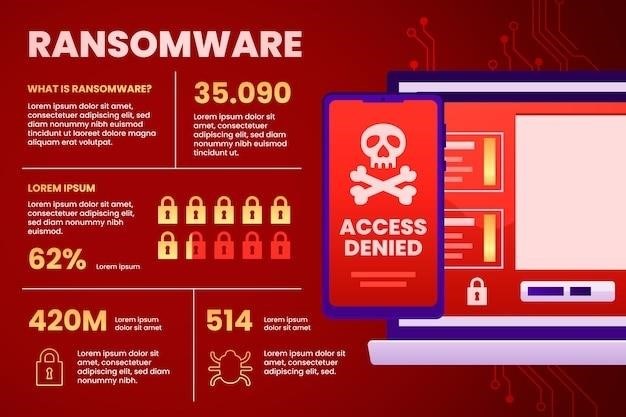Ethical Hacking Tutorial Syllabus⁚ A Comprehensive Guide
This comprehensive guide provides a detailed syllabus for an ethical hacking tutorial, covering fundamental concepts, essential tools, and real-world applications. Designed for beginners, this syllabus equips individuals with the knowledge and skills to understand ethical hacking principles, identify vulnerabilities, and secure systems effectively.
Introduction to Ethical Hacking
This section delves into the fundamental concepts of ethical hacking, laying the groundwork for understanding its purpose, principles, and applications. Ethical hacking, often referred to as penetration testing, is a proactive security measure that involves simulating real-world attacks to identify vulnerabilities and weaknesses in systems and networks. It is a crucial aspect of information security, as it allows organizations to strengthen their defenses and mitigate potential threats before malicious actors exploit them. By understanding the principles of ethical hacking, individuals can gain valuable insights into how attackers operate and learn how to protect their own systems from cyberattacks. This section will cover essential topics such as⁚
- Defining Ethical Hacking⁚ Explore the concept of ethical hacking, its significance in today’s digital landscape, and its distinction from illegal hacking.
- The Role of Ethical Hackers⁚ Understand the responsibilities and ethical obligations of ethical hackers, who are tasked with identifying and reporting security flaws in a responsible and legal manner.
- The Benefits of Ethical Hacking⁚ Discuss the numerous benefits of ethical hacking, including improved security posture, reduced risk of data breaches, and enhanced compliance with industry standards.
Understanding the Ethical Hacking Landscape
This section provides a comprehensive overview of the ever-evolving landscape of ethical hacking, encompassing its various facets, key players, and evolving trends. It explores the dynamic nature of cybersecurity threats, the increasing sophistication of hacking techniques, and the constant need for adaptation and innovation in the field of ethical hacking. By gaining a deep understanding of the ethical hacking landscape, individuals can stay ahead of emerging threats, anticipate future challenges, and develop a forward-thinking approach to security. Key aspects covered in this section include⁚
- Types of Hackers⁚ Differentiate between various types of hackers, including white hat, black hat, and gray hat hackers, and understand their motivations, techniques, and ethical considerations.
- The Evolution of Hacking⁚ Trace the historical evolution of hacking, from early forms of system intrusion to contemporary cyberattacks, including the rise of organized crime and state-sponsored hacking.
- Emerging Threats⁚ Explore the latest cybersecurity threats, such as ransomware attacks, data breaches, social engineering scams, and the growing influence of artificial intelligence in hacking.
- The Role of Technology⁚ Discuss the impact of technological advancements on ethical hacking, including the development of new hacking tools, automation, and the increasing complexity of cyberattacks.
The Role of an Ethical Hacker
This section delves into the multifaceted role of an ethical hacker, exploring the essential skills, responsibilities, and ethical considerations involved in this critical field. Ethical hackers act as guardians of digital security, proactively seeking and mitigating vulnerabilities before malicious actors can exploit them. This section provides a clear understanding of the ethical hacker’s responsibilities, outlining the key activities they perform and the impact they have on organizations and individuals. Key aspects covered include⁚
- Vulnerability Assessment⁚ Explore the process of identifying and analyzing vulnerabilities in systems, networks, and applications, utilizing various ethical hacking techniques and tools.
- Penetration Testing⁚ Explain the methodology of penetration testing, simulating real-world attacks to assess security weaknesses and provide actionable recommendations for improvement.
- Security Auditing⁚ Discuss the process of conducting security audits to evaluate the effectiveness of existing security controls, identify compliance gaps, and recommend necessary security enhancements.
- Security Awareness Training⁚ Highlight the importance of ethical hackers in developing security awareness programs for employees, educating them on best practices, common threats, and how to prevent security breaches.
- Ethical Considerations⁚ Emphasize the importance of ethical conduct, legal compliance, and respect for privacy when performing ethical hacking activities.
Legal and Ethical Considerations
This section examines the crucial legal and ethical considerations that are paramount in ethical hacking, emphasizing the importance of responsible and lawful practices. It provides a clear understanding of the legal frameworks that govern ethical hacking activities, as well as the ethical principles that guide the actions of ethical hackers. Key topics covered include⁚
- Legal Frameworks⁚ Explore relevant laws and regulations, such as the Computer Fraud and Abuse Act (CFAA) in the United States, the UK’s Computer Misuse Act, and the EU’s General Data Protection Regulation (GDPR), which govern access to computer systems and data.
- Informed Consent⁚ Discuss the importance of obtaining informed consent from individuals or organizations before conducting any ethical hacking activities, ensuring transparency and respect for privacy.
- Data Privacy⁚ Emphasize the ethical obligation to protect sensitive data, including personal information, financial records, and intellectual property, during ethical hacking engagements.
- Ethical Guidelines⁚ Introduce ethical guidelines for ethical hackers, such as those established by organizations like the International Information Systems Security Certification Consortium (ISC)² and the EC-Council, which promote responsible and professional conduct.
- Professional Conduct⁚ Stress the significance of maintaining professionalism, integrity, and accountability when performing ethical hacking tasks, upholding the reputation of the ethical hacking profession.
Types of Ethical Hacking Tests
This section delves into the diverse range of ethical hacking tests, providing a comprehensive overview of the different types and their specific purposes. Each test focuses on evaluating different aspects of security, allowing organizations to identify and mitigate vulnerabilities across various systems and applications. This section explores key types of ethical hacking tests⁚
- Penetration Testing⁚ Covers a broad range of tests to simulate real-world attacks, evaluating the security of an organization’s entire infrastructure, from networks and systems to applications and data.
- Vulnerability Scanning⁚ Focuses on identifying known security flaws and vulnerabilities in systems, software, and networks using automated tools, providing a quick assessment of potential risks.
- Web Application Testing⁚ Specifically targets web applications, analyzing their security posture against common attacks, such as cross-site scripting (XSS), SQL injection, and authentication flaws.
- Wireless Security Testing⁚ Evaluates the security of wireless networks, assessing vulnerabilities in access points, network configuration, and encryption protocols.
- Social Engineering Testing⁚ Simulates social engineering attacks, evaluating the effectiveness of an organization’s security awareness programs and employee training in resisting phishing scams, pretexting, and other social engineering tactics.
- Red Teaming⁚ Employs a team of ethical hackers to simulate a real-world adversarial attack, testing an organization’s ability to detect, respond, and recover from sophisticated threats.
The Phases of Ethical Hacking
Ethical hacking follows a structured methodology, often referred to as the “Five Phases of Ethical Hacking,” providing a systematic approach to conducting security assessments and penetration testing. This section outlines each phase, detailing the activities involved and their significance in the overall ethical hacking process⁚
- Reconnaissance⁚ Involves gathering information about the target system or organization, including public data, network infrastructure, and employee details. This phase aims to build a comprehensive understanding of the target’s security posture and identify potential vulnerabilities.
- Scanning⁚ Utilizes specialized tools to scan the target system for open ports, services, and vulnerabilities. This phase helps identify potential entry points for attackers and provides a detailed view of the target’s network architecture.
- Gaining Access⁚ Focuses on exploiting identified vulnerabilities to gain unauthorized access to the target system. This phase involves using various techniques, such as password cracking, buffer overflow exploits, and social engineering.
- Maintaining Access⁚ Once access is gained, ethical hackers aim to maintain a persistent presence on the target system, potentially installing backdoors or escalating privileges. This phase helps assess the attacker’s ability to move laterally within the network and maintain control.
- Reporting⁚ Concludes the ethical hacking process with a detailed report outlining findings, vulnerabilities, and recommendations for remediation. This phase provides valuable insights for improving security measures and mitigating potential risks.
Essential Tools and Techniques
Ethical hackers employ a diverse array of tools and techniques to conduct thorough security assessments and penetration tests. This section delves into some of the most commonly used tools and techniques in ethical hacking, highlighting their functionalities and applications⁚
- Network Scanning Tools⁚ Nmap, Nessus, and OpenVAS are widely used for port scanning, vulnerability identification, and network mapping. These tools help in identifying open ports, services, and potential vulnerabilities in network devices.
- Password Cracking Tools⁚ John the Ripper, Hydra, and Hashcat are powerful tools for cracking passwords using various techniques, including brute force attacks, dictionary attacks, and rainbow table attacks.
- Exploitation Frameworks⁚ Metasploit Framework is a popular and versatile platform for developing and executing exploits, providing a comprehensive library of exploits for various vulnerabilities.
- Web Application Security Tools⁚ Burp Suite, ZAP (Zed Attack Proxy), and OWASP (Open Web Application Security Project) tools are essential for identifying and exploiting vulnerabilities in web applications, including cross-site scripting (XSS), SQL injection, and authentication flaws.
- Wireless Security Tools⁚ Aircrack-ng, Wireshark, and Kismet are used for analyzing wireless network traffic, detecting vulnerabilities in Wi-Fi networks, and conducting wireless penetration tests.
Common Vulnerabilities and Exploits
Understanding common vulnerabilities and exploits is crucial for ethical hackers to identify and mitigate potential security risks. This section explores some of the most prevalent vulnerabilities and the exploits associated with them⁚
- Cross-Site Scripting (XSS)⁚ XSS vulnerabilities allow attackers to inject malicious scripts into websites, potentially stealing user credentials, redirecting users to malicious websites, or manipulating website functionality.
- SQL Injection⁚ SQL injection exploits vulnerabilities in web applications that accept user input and pass it directly to a database. Attackers can manipulate queries to access sensitive data, modify data, or even execute arbitrary commands on the database server.
- Buffer Overflow⁚ Buffer overflow vulnerabilities occur when a program attempts to write more data into a buffer than it can hold, potentially overwriting adjacent memory locations and leading to code execution or denial-of-service attacks.
- Denial-of-Service (DoS)⁚ DoS attacks aim to disrupt the availability of a service by overwhelming the target system with requests or traffic, rendering it unable to respond to legitimate users.
- Man-in-the-Middle (MitM)⁚ MitM attacks involve intercepting communication between two parties, allowing the attacker to eavesdrop on the conversation, modify the data, or even impersonate one of the parties.

Ethical Hacking in Action⁚ Real-World Scenarios
This section delves into real-world scenarios where ethical hacking techniques are applied to assess and improve security. These examples showcase the practical applications of ethical hacking principles and demonstrate the value of proactive security measures⁚
- Penetration Testing⁚ Ethical hackers conduct penetration tests to simulate real-world attacks against an organization’s systems, identifying vulnerabilities and weaknesses that could be exploited by malicious actors. This helps organizations strengthen their security posture and mitigate potential risks.
- Vulnerability Assessments⁚ Vulnerability assessments are used to identify potential security weaknesses in an organization’s systems and applications. Ethical hackers use various tools and techniques to scan for vulnerabilities, providing insights into potential attack vectors and recommending remediation strategies.
- Red Teaming⁚ Red teaming involves simulating adversarial attacks against an organization’s security controls, testing the effectiveness of security measures in a realistic scenario. Red teams use a range of techniques, including social engineering, phishing, and exploit development, to challenge an organization’s defenses.
- Bug Bounty Programs⁚ Bug bounty programs incentivize ethical hackers to discover and report vulnerabilities in software or systems, offering rewards for finding and disclosing security flaws. These programs help organizations improve their security by proactively identifying and addressing potential vulnerabilities.

Building a Strong Ethical Hacking Foundation
A solid foundation in ethical hacking is essential for aspiring professionals. This section outlines key steps to develop a strong ethical hacking foundation, emphasizing practical learning and continuous improvement⁚
- Master the Fundamentals⁚ Start by acquiring a strong understanding of networking concepts, operating systems, and security principles. This foundation will enable you to grasp complex ethical hacking techniques and effectively analyze vulnerabilities.
- Hands-on Experience⁚ Practical experience is crucial in ethical hacking. Set up a secure lab environment, experiment with tools and techniques, and practice performing ethical hacking tasks. This hands-on approach will solidify your understanding and develop practical skills.
- Stay Updated⁚ The cybersecurity landscape is constantly evolving, with new vulnerabilities and threats emerging regularly. Stay updated on the latest security trends, techniques, and tools through online resources, industry conferences, and training courses.
- Ethical Considerations⁚ Ethical hacking requires a strong sense of responsibility and a commitment to ethical conduct. Understand the legal and ethical implications of your actions and ensure that your activities are conducted within legal and ethical boundaries.
- Networking and Collaboration⁚ Connect with other ethical hackers, cybersecurity professionals, and industry experts. Attend conferences, join online forums, and participate in security communities to share knowledge, learn from others, and stay informed about industry trends.
Resources and Further Learning
Continuing your ethical hacking journey requires access to valuable resources and opportunities for further learning. Here are some recommended resources and pathways for enhancing your expertise⁚
- Online Courses and Certifications⁚ Platforms like Coursera, Udemy, and edX offer comprehensive ethical hacking courses, covering various topics from penetration testing to web application security. Consider pursuing certifications like the Certified Ethical Hacker (CEH) or the Offensive Security Certified Professional (OSCP) to validate your skills and demonstrate your expertise.
- Books and Articles⁚ Numerous books and articles provide in-depth knowledge on ethical hacking, covering specific techniques, tools, and methodologies; Explore resources like “The Hacker’s Playbook 3” by Peter Kim and “Ethical Hacking and Penetration Testing” by Michael Gregg.
- Security Blogs and Forums⁚ Stay abreast of the latest security trends by following industry blogs and forums. Websites like Hacker News, SecurityWeek, and Threatpost offer valuable insights, news, and discussions on cybersecurity.
- Capture the Flag (CTF) Competitions⁚ Participate in Capture the Flag (CTF) competitions to test your skills in a challenging and engaging environment. These events provide opportunities to hone your technical abilities and learn from experienced hackers.
- Open Source Tools and Projects⁚ Engage with the open source community by exploring and contributing to ethical hacking tools and projects. This hands-on approach will enhance your technical skills and provide insights into the development of security tools.



